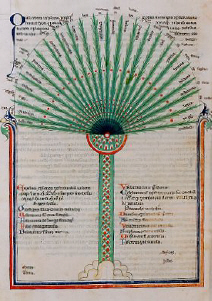18. These problems at any rate all serve to show that, while in general it is necessary to look for differences by which to separate things from each other, to hunt for differences of the differences themselves is both futile and irrational. We cannot have substances of substances, quantities of quantities, qualities of qualities, differences of differences; differences must, where possible, be found outside the genus, in creative powers and the like: but where no such criteria are present, as in distinguishing dark-green from pale-green, both being regarded as derived from white and black, what expedient may be suggested?
Sense-perception and intelligence may be trusted to indicate diversity but not to explain it: explanation is outside the province of sense-perception, whose function is merely to produce a variety of information; while, as for intelligence, it works exclusively with intuitions and never resorts to explanations to justify them; there is in the movements of intelligence a diversity which separates one object from another, making further differentiation unnecessary.
Do all qualities constitute differentiae, or not? Granted that whiteness and colours in general and the qualities dependent upon touch and taste can, even while they remain species [of Quality], become differentiae of other things, how can grammar and music serve as differentiae? Perhaps in the sense that minds may be distinguished as grammatical and musical, especially if the qualities are innate, in which case they do become specific differentiae.
It remains to decide whether there can be any differentia derived from the genus to which the differentiated thing belongs, or whether it must of necessity belong to another genus? The former alternative would produce differentiae of things derived from the same genus as the differentiae themselves – for example, qualities of qualities. Virtue and vice are two states differing in quality: the states are qualities, and their differentiae qualities – unless indeed it be maintained that the state undifferentiated is not a quality, that the differentia creates the quality.
But consider the sweet as beneficial, the bitter as injurious: then bitter and sweet are distinguished, not by Quality, but by Relation. We might also be disposed to identify the sweet with the thick, and the Pungent with the thin: “thick” however hardly reveals the essence but merely the cause of sweetness – an argument which applies equally to pungency.
We must therefore reflect whether it may be taken as an invariable rule that Quality is never a differentia of Quality, any more than Substance is a differentia of Substance, or Quantity of Quantity.
Surely, it may be interposed, five differs from three by two. No: it exceeds it by two; we do not say that it differs: how could it differ by a “two” in the “three”? We may add that neither can Motion differ from Motion by Motion. There is, in short, no parallel in any of the other genera.
In the case of virtue and vice, whole must be compared with whole, and the differentiation conducted on this basis. As for the differentia being derived from the same genus as themselves, namely, Quality, and from no other genus, if we proceed on the principle that virtue is bound up with pleasure, vice with lust, virtue again with the acquisition of food, vice with idle extravagance, and accept these definitions as satisfactory, then clearly we have, here too, differentiae which are not qualities.
